Posted by: Northwest Eye in General on July 8, 2025
Overview
This article addresses a concern that many may feel uneasy about: sudden floaters in one eye. Conditions such as posterior vitreous detachment, retinal detachment, and eye trauma can be alarming. We understand that experiencing these symptoms can be distressing, and it’s essential to recognize their potential seriousness.
It’s common to feel anxious when faced with such changes in your vision. Seeking timely medical attention is crucial, as these symptoms may indicate underlying issues that could lead to permanent vision loss if not addressed promptly. Remember, you are not alone in this; many have faced similar concerns and found reassurance through seeking help.
We are here to help you through this process. Your vision is important, and taking action when you notice changes can make all the difference in maintaining your eye health.
Introduction
Experiencing sudden floaters in one eye can be quite alarming, often leading to immediate worries about your eye health. We understand how unsettling these visual disturbances can be. They may arise from various underlying conditions, some of which could pose serious risks to your vision. Understanding the causes of these floaters is crucial, as it empowers you to seek timely medical attention.
What are the most common reasons behind these sudden changes in vision? It’s important to know how to differentiate between harmless occurrences and those that require urgent care. Remember, you are not alone in this journey, and we are here to help you through the process.
Northwest Eye: Expert Diagnosis and Treatment for Eye Floaters
At Northwest Eye, we understand how concerning sudden floaters in one eye can feel. Our extensive eye care services are designed to help you identify and manage these issues with compassion and expertise. , including specialists in cataract procedures, utilize advanced diagnostic equipment such as dynamic ultra-widefield infrared confocal scanning laser ophthalmoscopy (IRcSLO). This innovative imaging technique allows us to evaluate the underlying causes of visual disturbances with precision, providing you with clarity and confidence in your care.
We understand that each patient is unique, which is why we develop tailored treatment plans that may include:
- Observation
- Laser Floater Treatment (LFT)
- Surgical options like YAG vitreolysis
This is particularly for patients experiencing sudden floaters in one eye, depending on the severity of your condition. Research indicates that around 70% of individuals experience significant improvement after just one session of YAG vitreolysis. This statistic reflects our commitment to achieving effective results for our patients.
Our dedication to quality eye care not only positions Northwest Eye as a leader in the field but also provides you with the reassurance needed when facing visual challenges such as spots. We are proud of the positive patient reviews that highlight our high satisfaction rates, underscoring the importance of personalized attention and advanced technology in achieving optimal eye health. Remember, we are here to help you through this process, ensuring you feel supported every step of the way.
Natural Aging Process: How It Leads to Eye Floaters
As we age, it’s common to notice changes in our vision, particularly the development of spots. This occurs due to a natural process where the vitreous gel inside the eye begins to liquefy and reduce, causing tiny collagen fibers to clump together. These clumps create shadows on the retina, which can appear as spots. Studies indicate that around 70% of individuals over 50 experience some level of visual disturbances, with this occurrence notably increasing by age 80.
While these spots are often harmless and part of the normal aging process, we understand that untreated spots can lead to complications, such as , which could risk permanent vision loss. In fact, 1 in 6 people may experience a retinal tear due to posterior vitreous detachment. Knowing the origin of these spots can help ease your concerns.
Regular eye examinations are crucial. They allow for monitoring any changes and ensure that potential complications, like retinal tears, are addressed promptly. If you notice sudden floaters in one eye or experience flashes of light, it’s important to seek assessment from an ophthalmologist. Remember, we are here to help you through this process and support your vision health.

Posterior Vitreous Detachment (PVD): A Key Cause of Sudden Floaters
Posterior Vitreous Detachment (PVD) occurs when the vitreous gel separates from the retina, often leading to sudden visual disturbances. We understand that this can be alarming, as patients may notice new specks appearing as dark spots or cobweb-like shapes in their vision. Research has shown that floaters are observed in over 90% of individuals, which correlates with vitreous opacities during examination. While PVD is generally not harmful, it can occasionally lead to more serious conditions, such as or detachment. Recognizing the signs of PVD is essential, as early intervention can prevent complications.
It’s common to feel anxious about these changes in your vision. Patients who seek care within the first day of experiencing symptoms have a higher incidence of retinal tears, highlighting the importance of timely treatment. We encourage routine eye examinations for anyone noticing sudden floaters in one eye, as it can indicate abrupt alterations in their sight. PVD occurrence is noted at:
- 24% for ages 50-59
- 87% for ages 80-89
This emphasizes the need for vigilance.
The risk of retinal damage varies between 8.2% and 47.6% in patients with PVD symptoms. This underscores the importance of being aware of your eye health and taking proactive steps. Remember, we are here to help you through this process.
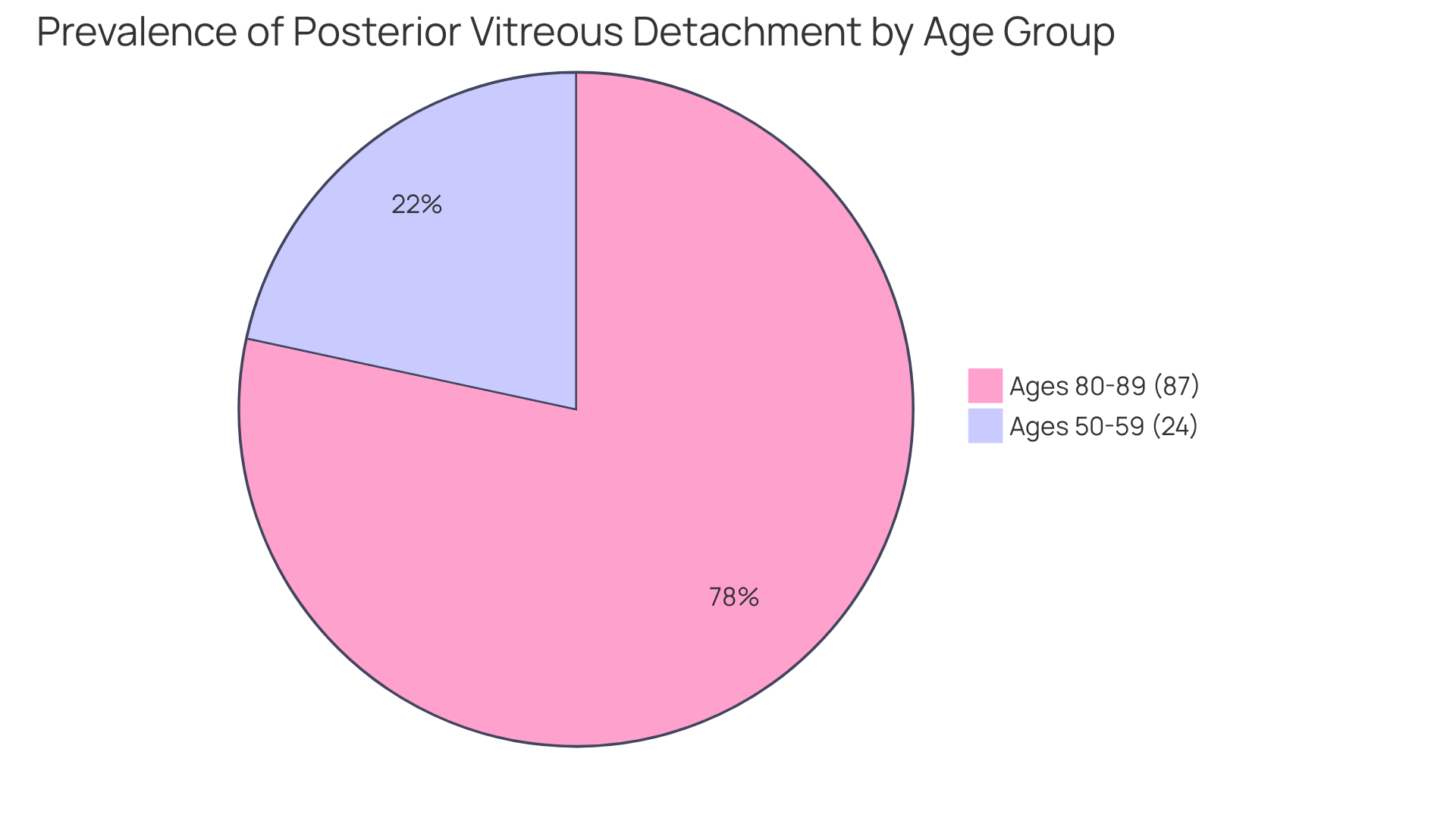
Retinal Detachment: Recognizing a Serious Cause of Floaters
Retinal detachment is a serious condition that can manifest with sudden floaters, often accompanied by flashes of light or a shadow in the outer field of sight. We understand that experiencing these symptoms can be alarming. This happens when the retina detaches from its usual place, which can result in permanent sight loss if not addressed quickly. It’s common to feel anxious in such situations, and we encourage you to seek immediate medical attention.
At Northwest Eye, we believe in empowering our patients through knowledge. We want you to , as this is vital for your well-being. Treatment options may include:
- Laser therapy
- Surgical intervention to reattach the retina and restore vision
We are here to help you through this process, ensuring you feel supported every step of the way.
Awareness of these symptoms is crucial for preserving eye health. Through our Be Eye Wise initiative, we strive to provide you with the information you need to make informed decisions about your care. Remember, we are here to support you, and together we can navigate your journey to better eye health.
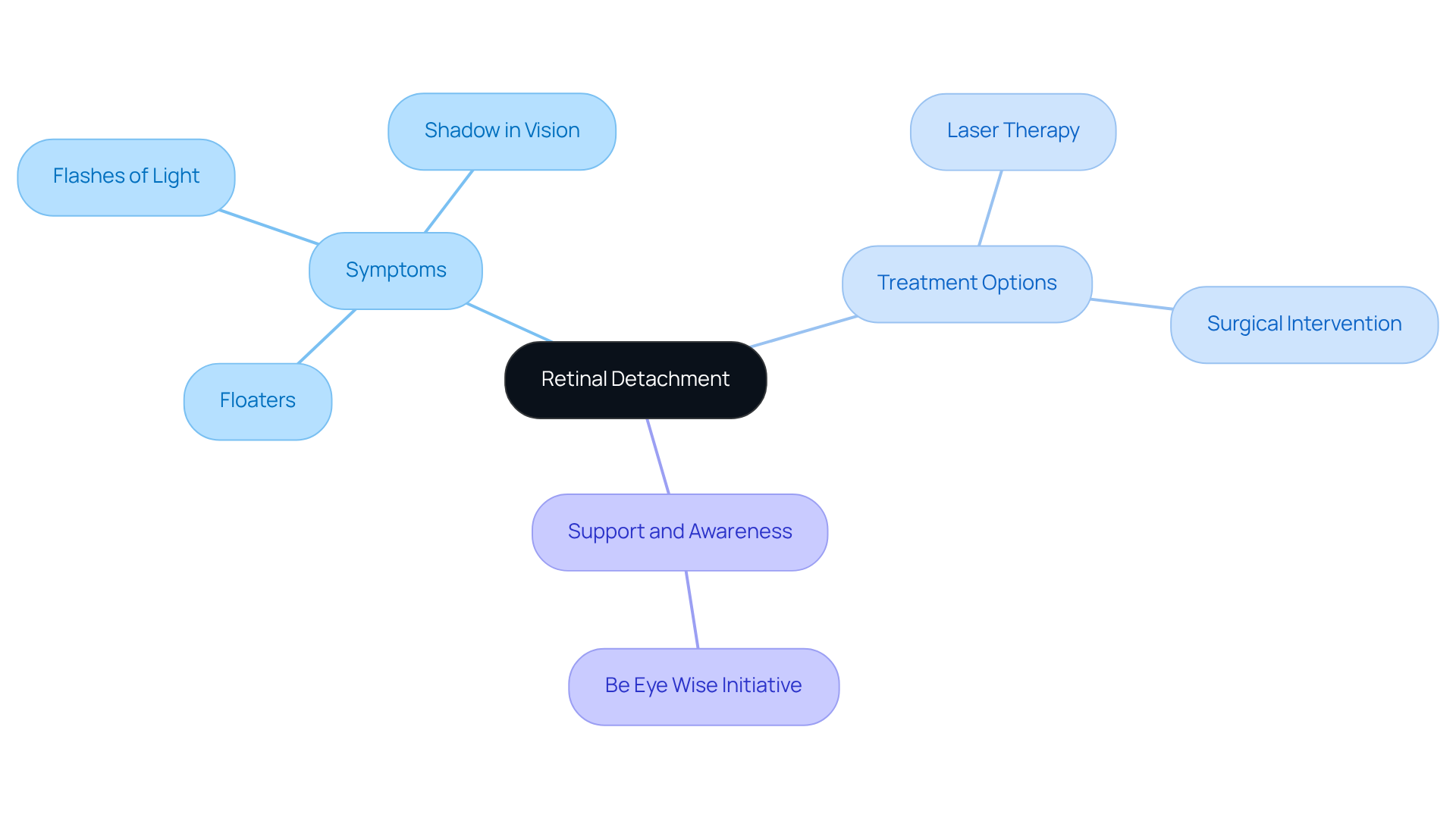
Eye Trauma: Understanding Its Role in Sudden Floaters
Eye trauma, whether from blunt force or penetrating injuries, can understandably cause concern about the appearance of spots in your vision. Studies show that about 8.9% of individuals experiencing sudden spots or flashes of light had a torn retina, while 39.7% had a posterior vitreous detachment—both of which can arise from eye injuries. When the vitreous gel is disrupted, it may lead to bleeding or inflammation, manifesting as spots in your visual field.
We understand that encountering recent eye injuries can be alarming. Ophthalmologists emphasize the importance of being vigilant for any changes in your sight, especially for sudden floaters in one eye. Seeking immediate evaluation by an eye care professional is crucial to assess the severity of the injury and determine the best treatment options available. This proactive approach can help minimize potential long-term impacts on your vision, as timely intervention is essential in preventing complications such as retinal tears or detachments.
Furthermore, with 18,510 reported cases of eye-related injuries in 2020, it’s vital to grasp the implications of such trauma on vision health. This understanding is especially important for and overall eye care. Remember, we are here to help you through this process, ensuring you receive the care and support you need.
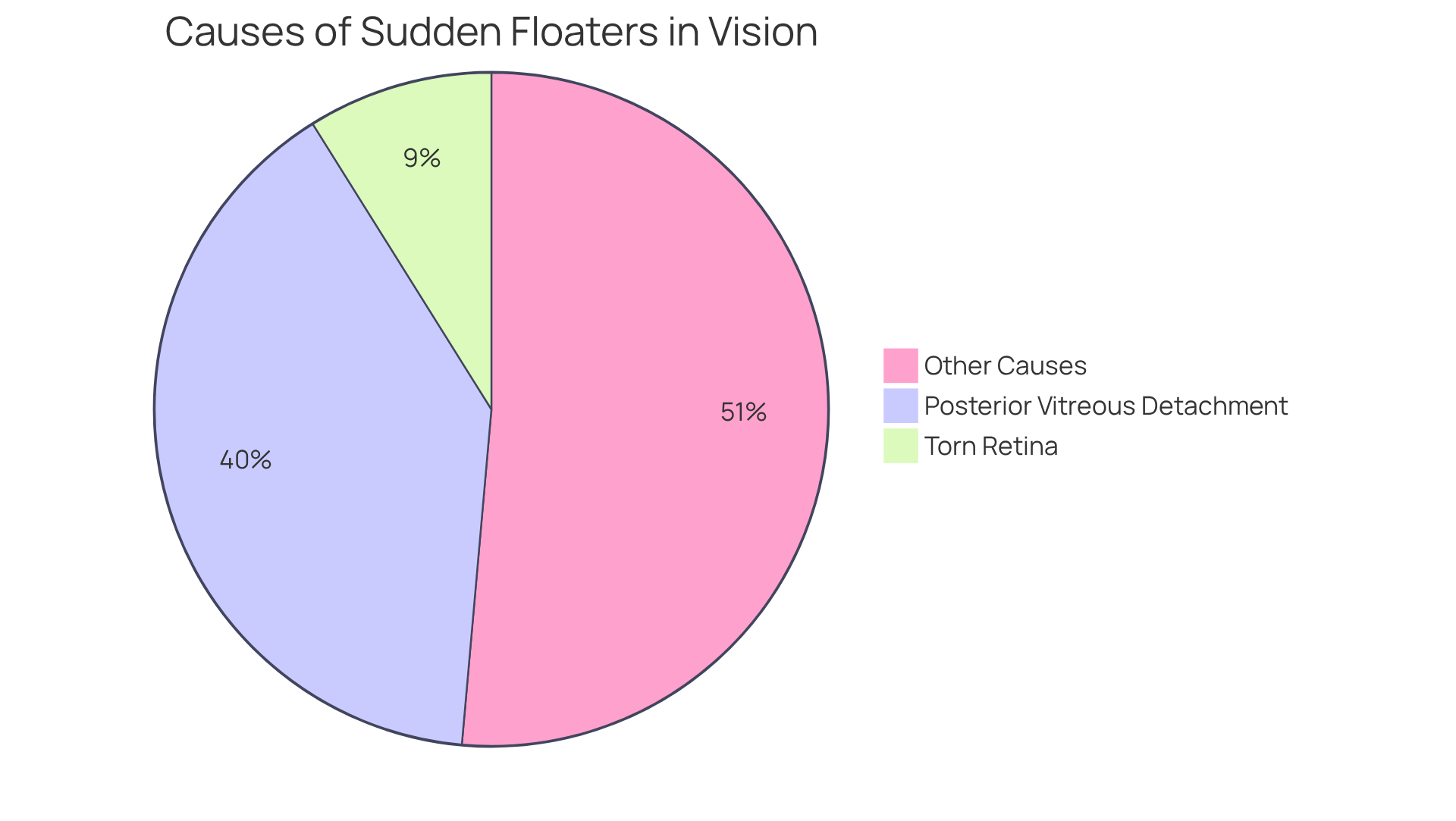
Nearsightedness (Myopia): A Contributing Factor to Eye Floaters
Nearsightedness, or myopia, can significantly affect your vision and may lead to the development of eye specks. We understand that individuals with high myopia often have elongated eyeballs, which can change the structure of the vitreous gel within the eye. This alteration increases the risk of posterior vitreous detachment, a condition where the vitreous gel separates from the retina. Many people report experiencing sudden floaters in one eye as a result of this issue.
It’s concerning to note that research suggests by 2050, nearly 5 billion individuals worldwide could be impacted by myopia. This highlights the importance of monitoring your eye health if you have nearsightedness. In fact, about 30% of those with myopia encounter visual disturbances, often noticing them at a younger age than those with typical eyesight.
Regular eye check-ups are crucial for myopic individuals. They help monitor changes in your sight and can address potential complications early on. Eye care specialists emphasize the importance of being attentive to visual disturbances, particularly sudden floaters in one eye, especially for those who are nearsighted, to prevent further sight problems.
As Thomas John Naduvilath, PhD, wisely noted, “Understanding the connection between myopia and visual disturbances is crucial for effective patient management and timely intervention.” We are here to help you through this process, ensuring you receive the care and support you need to .
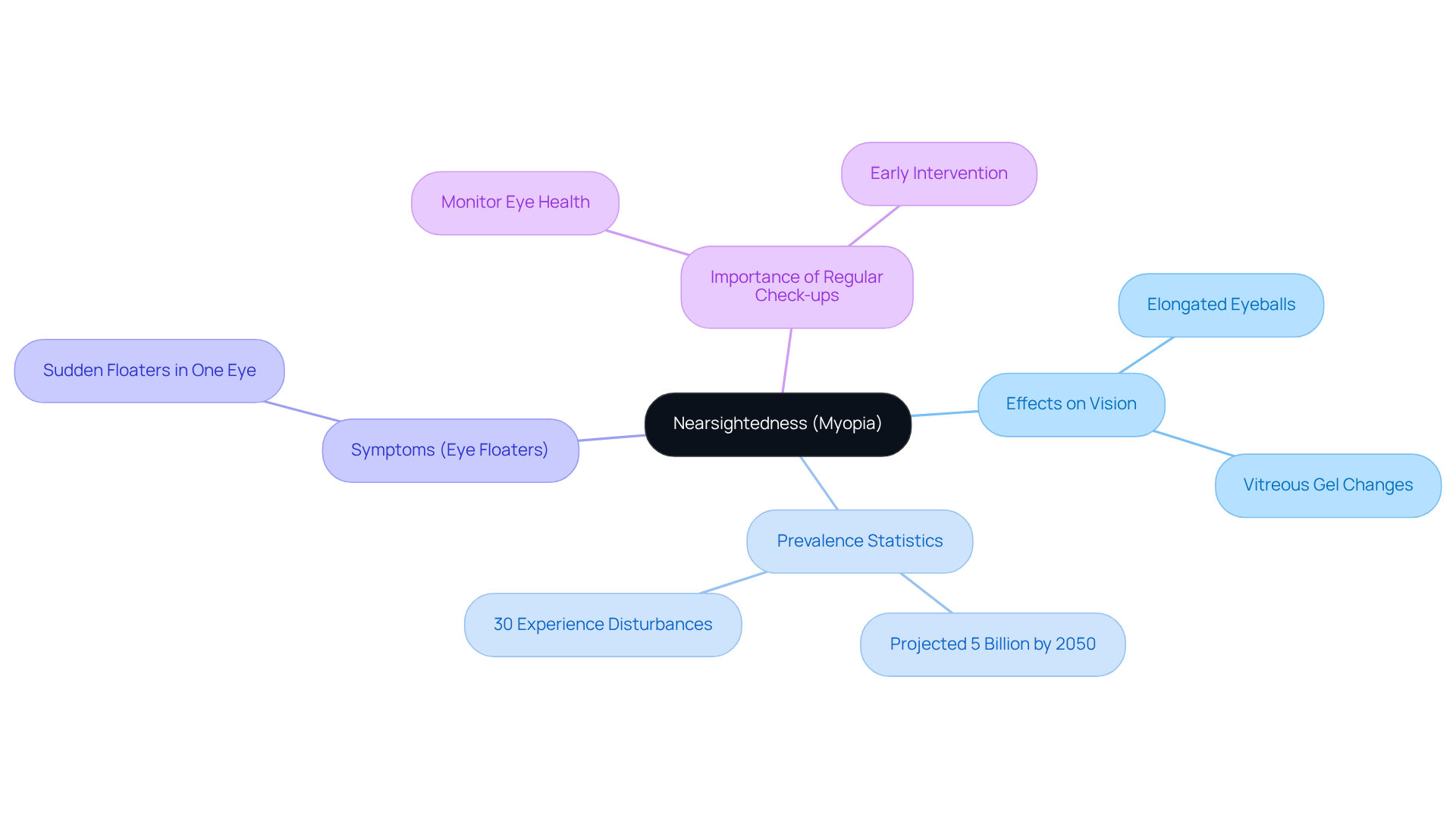
Vitreous Hemorrhage: A Serious Cause of Sudden Floaters
Vitreous hemorrhage occurs when blood leaks into the vitreous cavity, often causing in one eye. We understand that experiencing this can be concerning. This condition can arise from various factors, including retinal tears, diabetic retinopathy, or trauma. Patients may notice dark spots or streaks in their vision, which can significantly impact visual clarity.
The annual incidence of vitreous hemorrhage is notable, ranging from 7 to 15.4 cases per 100,000 persons. Studies indicate that it accounts for 31-54% of cases related to diabetic retinopathy and 11-44% due to ruptured normal vessels. Prompt assessment by an eye care specialist is crucial. In some cases, treatment may involve addressing the root cause of the hemorrhage, and sometimes surgical procedures may be necessary to regain sight.
It’s common to feel anxious about potential complications, such as ghost cell glaucoma and proliferative vitreoretinopathy, which can arise if the condition is not managed promptly. Additionally, we encourage patients to be monitored periodically for the clearing of vitreous hemorrhage, ensuring ongoing care and management. Remember, we are here to help you through this process.
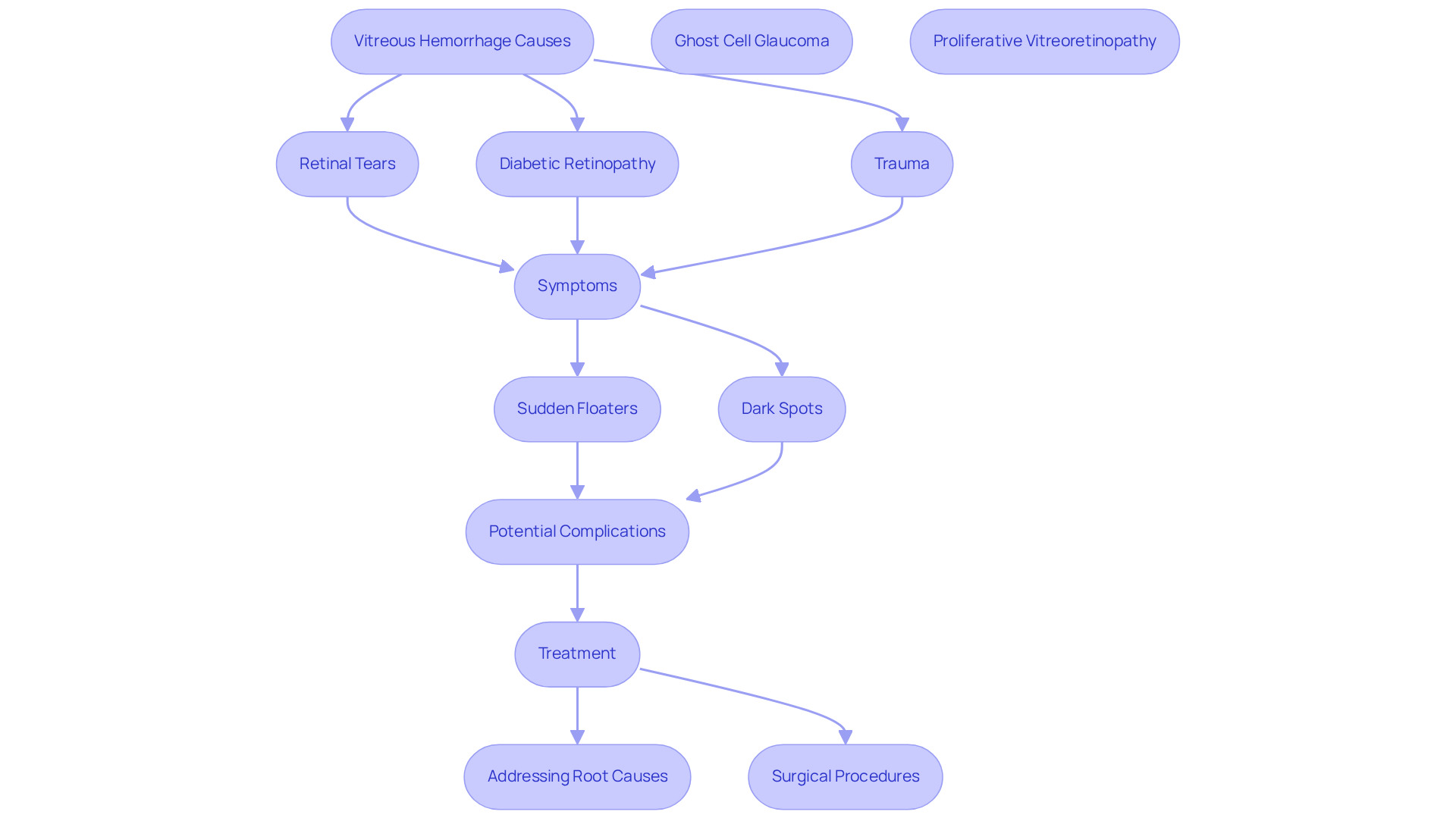
Sudden Onset of Floaters: When to Seek Medical Attention
Encountering sudden floaters in one eye can be alarming, especially when they are accompanied by flashes of light, peripheral sight loss, or a shadow blocking your field of vision. We understand that these symptoms can signal serious conditions such as or vitreous hemorrhage. It’s crucial to seek prompt evaluation and treatment to prevent irreversible vision loss. In fact, approximately 1 in 10 individuals who notice a sudden influx of spots and flashes may have a retinal tear.
It’s common to feel concerned, particularly as 75 percent of people over 65 experience visual disturbances. This highlights how prevalent this issue is within the target demographic. Regular eye exams are essential in monitoring changes in vision and addressing concerns early. We want to empower you to maintain optimal eye health.
Eye care experts stress that taking prompt action is vital. Therefore, if you observe sudden floaters in one eye or a sudden rise in spots in your vision accompanied by flashes of light, it is crucial to seek immediate medical attention to prevent further complications. Remember, emergency medical care is available 24/7, ensuring that help is readily accessible when these symptoms arise.
If the spots suggest another problem, treatment alternatives such as laser therapy or surgical procedures like vitrectomy may be required. This underscores the importance of pursuing prompt assistance. We are here to help you through this process, ensuring you receive the care you need.
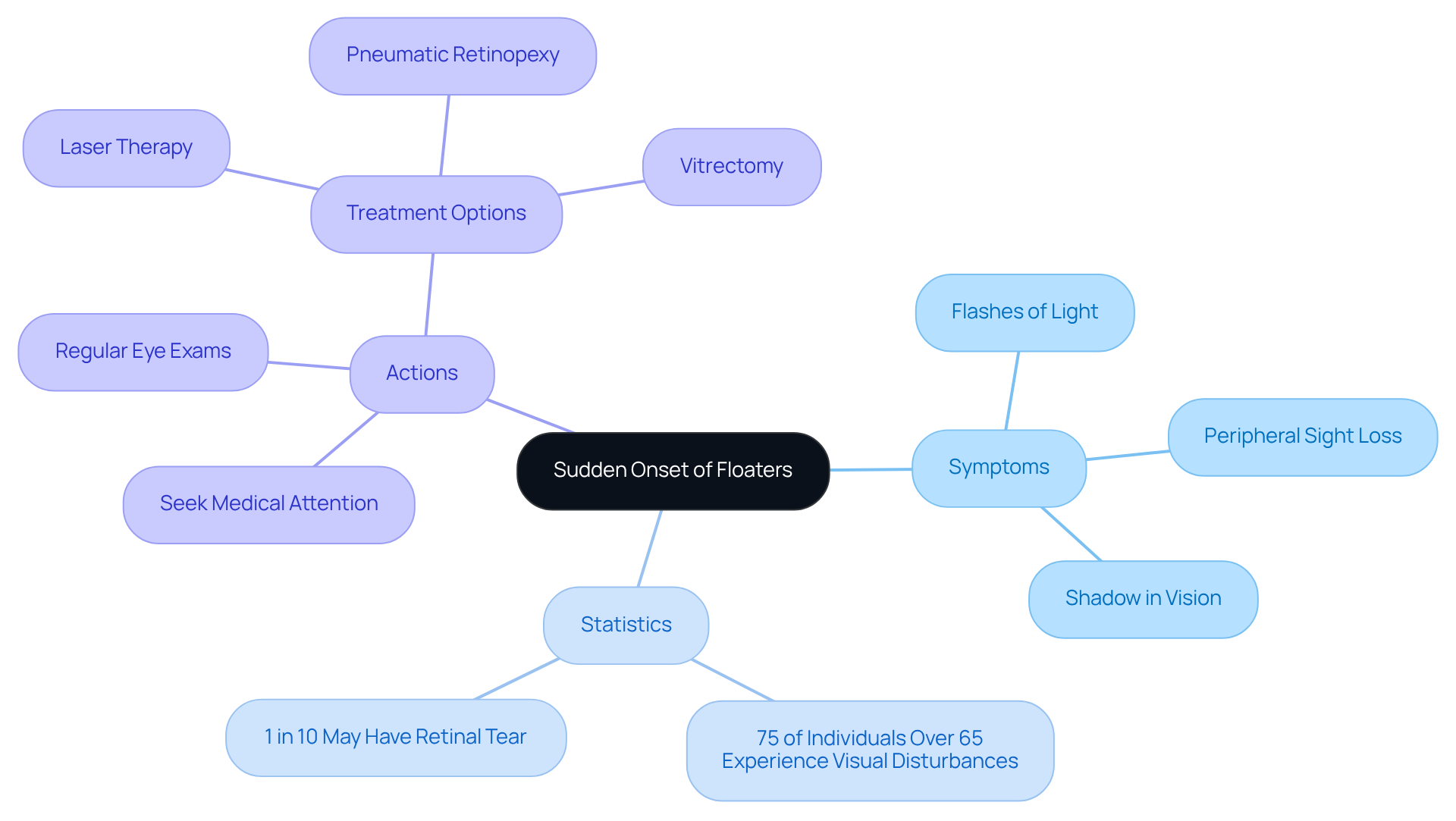
High Blood Pressure: A Risk Factor for Floaters and Flashes
Elevated blood pressure is a significant concern, often leading to sudden floaters in one eye as well as spots and flashes in vision. We understand that increased blood pressure can lead to , potentially resulting in bleeding or other issues that may present as sudden floaters in one eye. It’s important to note that almost half of U.S. adults suffer from hypertension, impacting around 119.9 million people; many of these individuals experience visual disturbances, including sudden floaters in one eye. In fact, studies indicate that nearly half of adults with hypertension report symptoms related to their condition, such as sudden floaters in one eye, underscoring the importance of being vigilant about eye health.
For patients with hypertension, prioritizing regular check-ups with an eye care provider is crucial. Swift assessment of any eye symptoms, such as sudden floaters in one eye, can help preserve retinal tissue and prevent permanent damage. We encourage managing blood pressure through lifestyle modifications—such as:
- Eating antioxidant-rich foods
- Wearing sunglasses rated for 100 percent UV protection
- Maintaining a healthy diet
- Engaging in regular exercise
- Adhering to prescribed medications
These steps can significantly reduce the risk of vision-related issues. For instance, a five-point drop in systolic pressure can help mitigate eye health risks, especially considering that about 1 in 4 adults with hypertension have their condition under control.
Creative treatment alternatives, such as laser therapy (YAG Vitreolysis) and vitrectomy, may be considered for individuals facing considerable difficulties with their sight; however, these measures are generally reserved for critical situations. Regular eye exams are essential for monitoring eye health, especially for individuals who may experience sudden floaters in one eye or have high blood pressure. We recommend scheduling a dilated eye exam every year or every six months if the retina shows changes. By recognizing the visual cues linked to hypertension, such as sudden floaters in one eye, and combining eye care with blood pressure management, patients can take proactive measures to safeguard their eyesight.
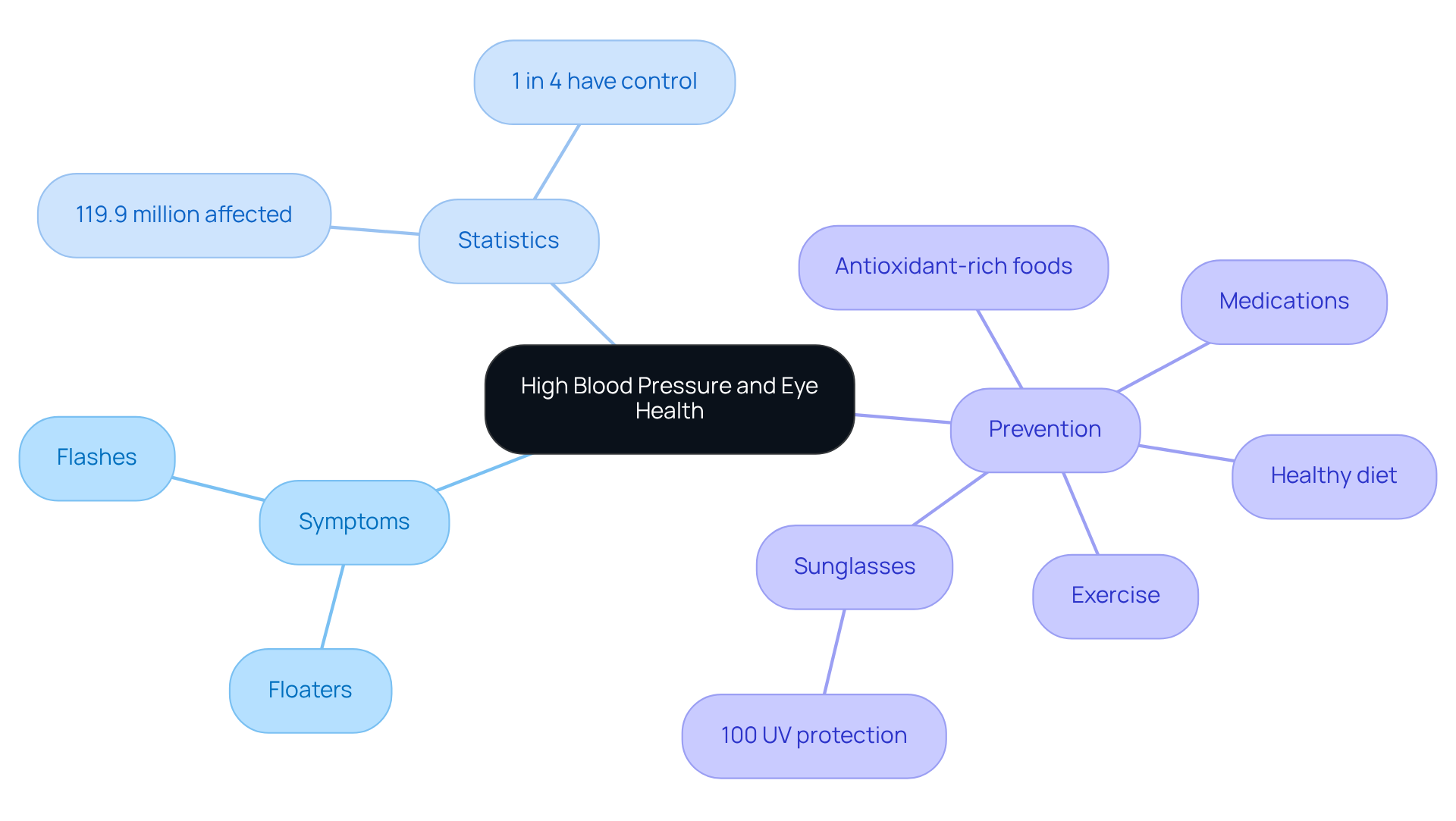
Recognizing Symptoms: When to Consult a Healthcare Professional About Floaters
If you notice sudden floaters in one eye, it’s important to reach out to a healthcare expert. This is especially true if you experience other symptoms, such as:
- Sudden floaters in one eye
- Flashes of light
- Blurred vision
- A dark curtain obscuring your field of view
We understand that can be alarming, as it may signal underlying issues like cataracts or more serious conditions, such as retinal detachment or vitreous hemorrhage, which require immediate medical attention.
Regular eye exams play a crucial role in monitoring your eye health and addressing any concerns promptly. We encourage you to take these symptoms seriously, as untreated issues can lead to serious health complications. Remember, understanding these signs is vital for maintaining your eye health, and we are here to help you through this process.
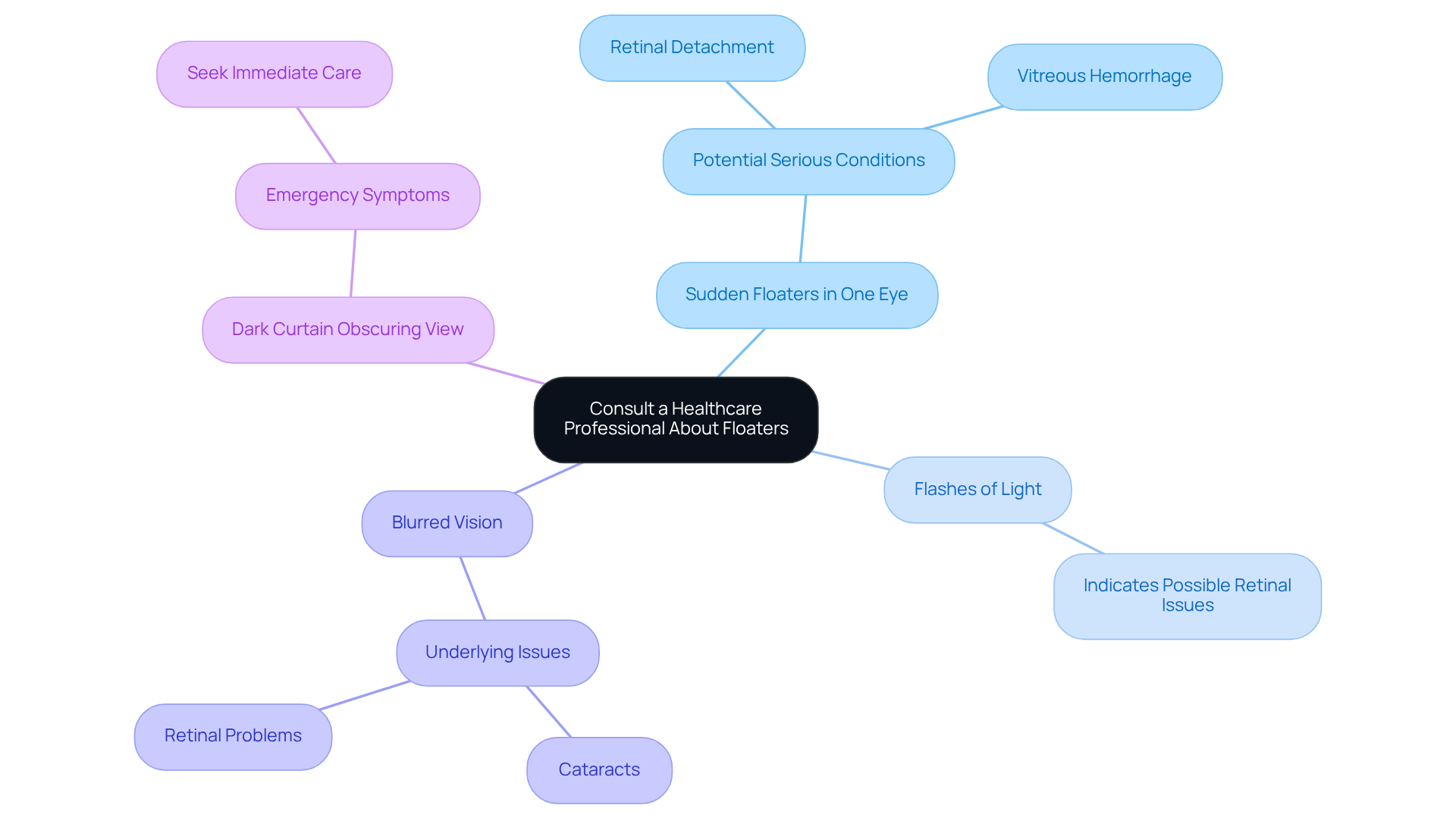
Conclusion
Experiencing sudden floaters in one eye can be quite concerning, often signaling underlying issues that need attention. We understand that this can be alarming, and it’s crucial to recognize the various causes, which range from natural aging and posterior vitreous detachment to more serious conditions like retinal detachment and vitreous hemorrhage. By understanding these symptoms and seeking timely medical advice, you can significantly impact your prognosis and treatment outcomes.
Throughout this article, we shared key insights, including:
- The importance of regular eye examinations
- The need for immediate consultation when you notice symptoms like flashes of light or blurred vision
It’s common to feel worried, especially knowing that high blood pressure and myopia can contribute to floaters. This highlights the interconnectedness of your overall health and vision. Additionally, we emphasized the effectiveness of treatments available at Northwest Eye, which are tailored to meet individual patient needs, ensuring a comprehensive approach to eye care.
In summary, being proactive about your eye health is essential. If you are experiencing sudden floaters, please don’t hesitate to seek professional evaluation. Early intervention can prevent serious complications and help preserve your vision. By staying informed and vigilant, you can take significant steps toward protecting your sight and enhancing your overall well-being. We are here to help you through this process.
Frequently Asked Questions
What are eye floaters and why do they occur?
Eye floaters are small spots or specks that appear in a person’s vision, often caused by the natural aging process where the vitreous gel inside the eye begins to liquefy and clump together, creating shadows on the retina.
How common are eye floaters among older adults?
Studies indicate that around 70% of individuals over 50 experience some level of visual disturbances, with the occurrence notably increasing by age 80.
What should I do if I notice sudden floaters in one eye?
If you notice sudden floaters or experience flashes of light, it is important to seek assessment from an ophthalmologist to ensure proper evaluation and management.
What is Posterior Vitreous Detachment (PVD)?
PVD occurs when the vitreous gel separates from the retina, often leading to sudden visual disturbances such as new specks or cobweb-like shapes in vision.
Is PVD harmful and what are the potential complications?
While PVD is generally not harmful, it can occasionally lead to serious conditions like retinal tears or detachment. Early intervention is crucial to prevent complications.
What percentage of individuals experience floaters related to PVD?
Research shows that floaters are observed in over 90% of individuals with vitreous opacities during examination.
How can Northwest Eye assist with eye floaters?
Northwest Eye offers expert diagnosis and treatment for eye floaters, including observation, Laser Floater Treatment (LFT), and surgical options like YAG vitreolysis, tailored to each patient’s condition.
What are the success rates of YAG vitreolysis treatment?
Research indicates that around 70% of individuals experience significant improvement after just one session of YAG vitreolysis.
Why are regular eye examinations important?
Regular eye examinations are crucial for monitoring changes in vision and addressing potential complications, such as retinal tears, promptly.
What age groups are most at risk for PVD?
The occurrence of PVD is noted at 24% for ages 50-59 and 87% for ages 80-89, emphasizing the need for vigilance in eye health.






